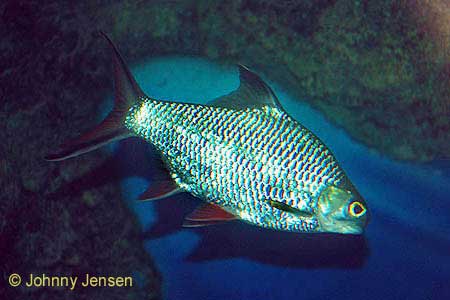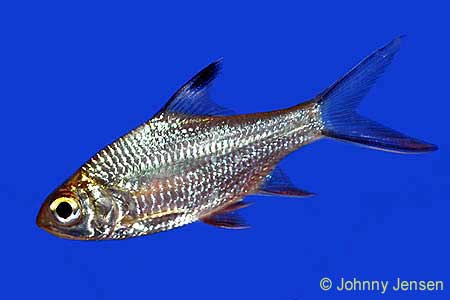Barbs
Barbs are a beginners tropical fish, but they need a bit of extra attention. Barbs get their name from the small barbels around their mouth. The barbels are similar to those on a catfish, but barbs are small, fast moving swimmers. Barbs have a reputation for nipping the fins of other fish, so guppies and bettas are not good tank mates.
Cherry Barb

Male Cherry Barb
The Cherry Barb is a good choice for
beginners. It comes from Sri Lanka. The cherry barb is much more peaceful, slower
and smaller than other barbs. As it matures, it develops its cherry color. Males turn a bright fire red when they reach breeding age. There is no distinction between sexes for juveniles and they all look very similar to an
adult female. Cherry Barbs don't school, so keeping a pair is fine, although they will enjoy the company of
their own kind. They eat standard flake foods and freeze dried blood worms. Quality flake foods and
brine shrimp feedings will enhance colors.

Female Cherry Barb
Cherry Barb - Breeding
For breeding, a separate tank should be used. Cherry Barbs will breed on a regular period of about every 3 weeks. Separating the male and female before breeding can help, but a bonded pair will develop a consistent pattern without being separated. The male begins chasing the female continuously when she is ready to spawn. When they breed, the male wraps around the female to fertilize the egg as she releases it. The process is repeated many times over a period of several minutes to an hour.

Cherry Barb Juveniles
Cherry Barb - Raising Fry
Cherry Barbs will spread eggs on finely leaved plants, such as Cabomba. Eggs that fall to the bottom of the tank will hatch there too. After spawning, the parents should be removed to increase survival rates. The parents will rarely search through gravel and plants for eggs if they adequately fed, so it is possible to leave them in the breeding tank and successfully raise some young. The fry will hatch in a few days and they are very tiny light brown to almost colorless slender slivers. They quickly begin searching for food among plant leaves, rocks and gravel. If the parents are left in the tank and there are no other predators, some of the fry will survive being consumed. Brine shrimp and finely crushed flakes are excellent food sources too. If breeding parents are left in the same tank with some fry, eventually the fry will become large enough to eat eggs and young fry themselves, at which point no new young will survive.

Cherry Barb Male
Cherry Barbs - Profile
-
Scientific Name: Puntius titteya
-
Family: Cyprinid
-
Temperature: 23 - 27 C; 73 - 81 F
-
pH: 6.0 - 8.0
-
Size: 5 cm; 2 inches
-
Life Span: 5 - 7 years
-
Breeding: Normal, Egglayer
Cherry Barb - Compatibility:
Cherry Barbs are compatible with most other Barbs, especially the Checkered Barb. Cherry Barbs also make good tank mates with the Chinese Algae Eater, Clown Loaches, Danios, Gouramis, Mollies, Platies, Plecostomus, one
Red Tailed Shark, Rainbow Shark, Silver Dollar, Swordtails.
Aggressive male tiger barbs are not compatible with cherry barbs.
Tiger Barb

Tiger Barb
Tiger Barbs originally come from Indonesia. They are known by the scientific names Barbus tetrazona, Puntius tetrazona and Capoeta tetrazona. The scientific name "tetrazona" refers to the four striped zones across its body. Tiger Barbs are easy to keep and are very active. They are also found in a Green and a Gold variety. Tiger Barbs like to swim in groups, so 8 or more are recommended for a tank.
Tiger Barb - Fin Nippers
Male tiger barbs can be very aggressive. Some aggressive males tend to attack their own kind or other species if no other tiger barbs are in the tank. They prefer bushy plants and lots of open swimming rea. Tiger Barbs are fin nippers, so don't mix them with slow moving fish such as many of the tetra group, guppies or bettas. They eat standard flake foods and freeze dried blood worms.

Green Tiger Barb
Tiger Barbs - Breeding
Females can be recognized by the heavier bodies when laden with eggs.
Males tend to have red on their fin tips. For breeding, a separate tank
should be used. Temperatures should be near 80. Separating the male
and female before breeding will help. Tiger Barbs will spread adhesive
eggs all over the aquarium. After spawning, the parents should be
removed. The fry will hatch in a few days. Brine shrimp is best for
feeding the fry, although finely crushed flakes will work.

Green Tiger Barb
Breeding Tiger Barbs by Dano
Tiger Barbs are egg-scatterers that provide no parental care. They will eat their own eggs if they have the opportunity. So, set up a separate breeding tank, which can double as a grow-out tank for the fry. Females have a broader more rounded belly, and are larger than the more highly colored males. To acquire a breeding pair, keep at least a half dozen in your main tank and allow them to pair off. Condition the breeders with live foods. Once a pair has been established, move them to the separate breeding tank.
Tiger Barbs - Profile
-
Scientific Name: Barbus tetrazona
-
Family: Poeciliid
-
Temperature: 20 - 29 C; 68 - 85 F
-
pH: 6.0 - 8.0
-
Size: 7 cm; 3 inches
-
Life Span: 5 - 7 years
-
Breeding: Normal, Egg Layer

Schooling Tiger Barbs
Tiger Barb - Compatibility:
Tiger Barbs are compatible with other Barbs, Clown Loaches, Danios, Gouramis, Mollies, Platies, Plecostomus, one Red Tailed Shark, Rainbow Shark, Silver Dollar, Swordtails
Rosy Barb

Rosy Barb
The Rosy Barb is a good choice for beginners as it is very hardy. It comes from India. It is known by the scientific names Puntius conchonius and Barbus conchonius. Rosy Barb Males are a
deep red when ready to breed, while females have a yellow base to their color. A small dark patch is apparent just before the tail fin. Breeders have also developed a Long Fin Rosy Barb and a Neon Rosy Barb. Rosy Barbs are active swimmers and need open space. They will also dig in gravel. Rosy Barbs are a schooling fish and should be kept in groups of 4 - 6 or more to reduce aggression. Feed Rosy Barbs standard flake foods, freeze dried blood worms and occasional live brine shrimp. Cooler temperatures and a quality diet can improve their colors.
Rosy Barb - Breeding
For breeding, a separate tank should be used and make sure it doesn't have a filter that will siphon up the fry. Separating the male and female before breeding can help. Soft water is preferred. Rosy Barbs will spread hundreds of clear eggs on finely leaved plants, such as Cabomba. After spawning, the parents should be removed. The fry will hatch in a few days and they are very tiny. Brine shrimp is best for feeding the fry, although finely crushed flakes may work.
Rosy Barb - Profile
-
Scientific Name: Barbus conchonius
-
Family: Cyprinid
-
Temperature: 18 - 23 C; 64 - 74 F
-
pH: 6.0 - 8.0
-
Size: 11 cm; 4 inches
-
Life Span: 5 - 7 years
-
Breeding: Normal, Egglayer
Rosy Barb - Compatibility:
Rosy Barbs are compatible with other Barbs, Chinese Algae Eaters, Clown Loaches, Danios, Gouramis, Mollies, Platies, one Red Tailed Shark, Rainbow Sharks, Silver Dollars, Swordtails
Torpedo Barb

Torpedo Barb
submitted by Laura - The
Torpedo Barbs are gorgeous, energetic, and actually gentle giants
.... They chase each other, but that is it, I have Cardinals,
White Clouds, and Cherry Barbs in with them along with my Angels, Gold
Barbs, Congo Tetra's and a Rainbow Shark .... Oh, and some Rainbows
of course !!
Torpedo Barb Profile
-
Scientific Name: Puntius denisonii
-
Family: Cyprinid
-
Temperature: 15 - 25 C; 60 - 75 F
-
pH: 6.8 - 7.8
-
Size: 15 cm; 6 inches
-
Life Span: 5 years
-
Breeding: Difficult, Egglayer
Torpedo Barb - Compatibility:
Torpedo Barbs are compatible with freshwater Angelfish, Cardinal Tetras, Cherry Barbs, Congo Tetras, Gold Barbs, Rainbowfish, Rainbow Sharks, White Clouds
Tinfoil Barb

Tinfoil Barb
The Tinfoil Barb originates from southeast Asia. It is known by the
scientific names Barbus schwanefeldi, Barbonymus schwanenfeldii and Puntius schwanenfeldii. The Tinfoil Barb has silver plated scales, producing color variations reminiscent of tinfoil. The dorsal fin is often red with a black tip. Other fins are often red as well. The forking of the tail fin increases their speed.
Tinfoil Barb - Care
The Tinfoil needs a tank of at least 50 gallons because of its size. The tank can be decorated, but mature Tinfoils don't require any plant cover. They do enjoy eating plants, though. Tinfoils are mild tempered and do not match the aggressive profile of most barbs. Tinfoil Barbs are an excellent community fish, but they will eat smaller fish. Their speed allows them to avoid aggressive tank mates and their skittish
qualities can lead them to jump out of the tank. Tinfoil Barbs are a schooling fish and should be kept in groups of 6 or
more. Feeding should consist of flake foods, pellets, tubifex, vegetable matter, brine shrimp and small fish.

Tinfoil Barb
Tinfoil Barb - Dither Fish
Tinfoils are often suggested as a dither fish. That means they are sadly used as a fish that can be chased around the tank. As a dither fish, Tinfoil Barbs are used to reduce aggression among cichlids. Their speed continually brings them near cichlids, who chase them away. The cichlids concentrate on the Tinfoils and stop fighting among themselves. Think about what it means to be a dither fish, because it's a very unpleasant life style for the Tinfoil Barb.
Tinfoil Barb - Profile
-
Scientific Name: Barbus schwanefeldi
-
Family: Cyprinid
-
Temperature: 22 - 25 C; 72 - 77 F
-
pH: 6.5 - 7.0
-
Size: 35 cm; 14 inches
-
Life Span: 8 years
-
Breeding: Difficult, Egglayer
Tinfoil Barb - Compatibility:
The Tinfoil Barb is compatible with the Bala Shark, Barbs, Clown Loaches, Danios, larger
Gouramis, Oscars, Plecos, Rainbowfish, Rainbow Sharks, Silver
Dollars
The Tinfoil often gets the unpleasant life of a dither fish for New World cichlids.
|











